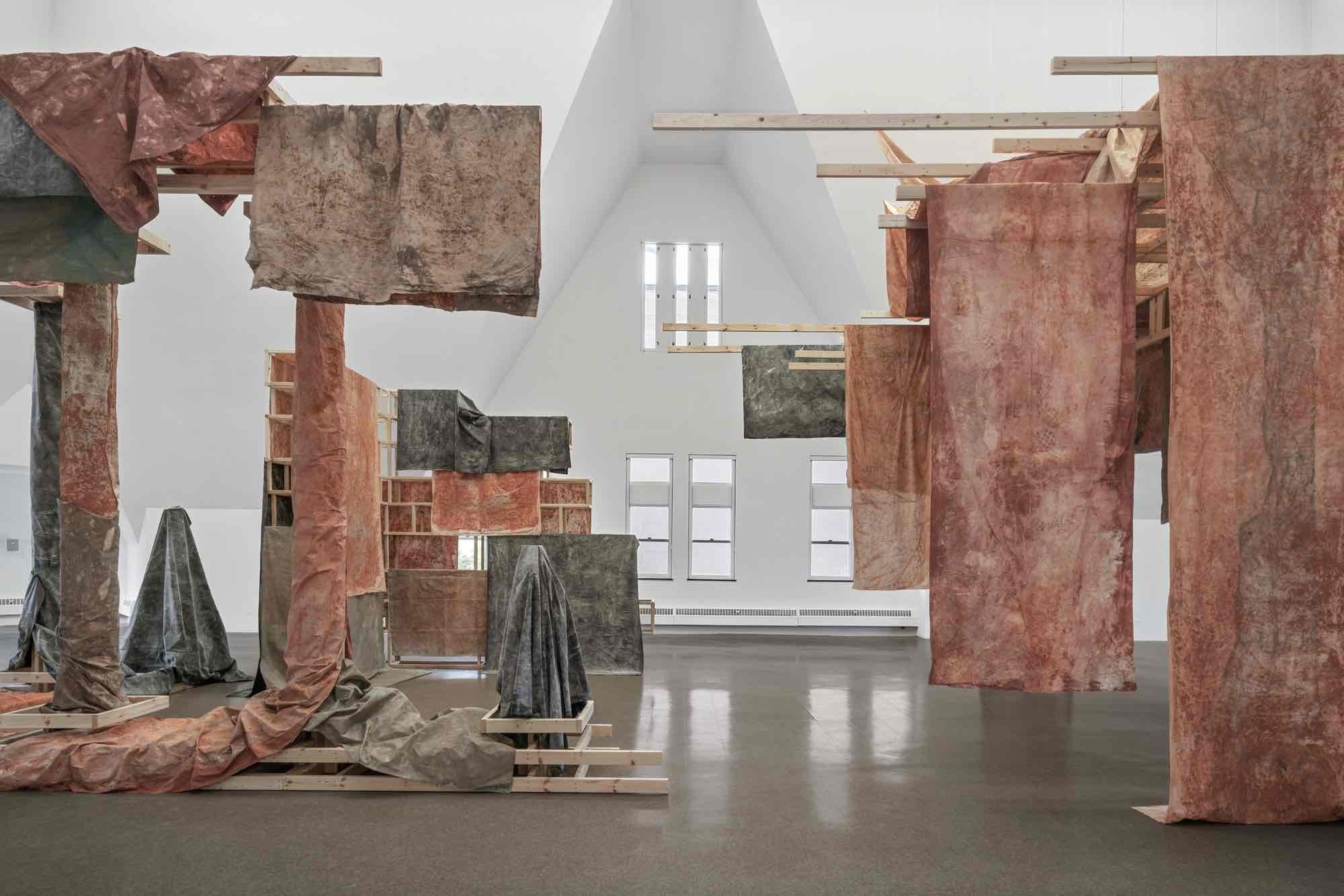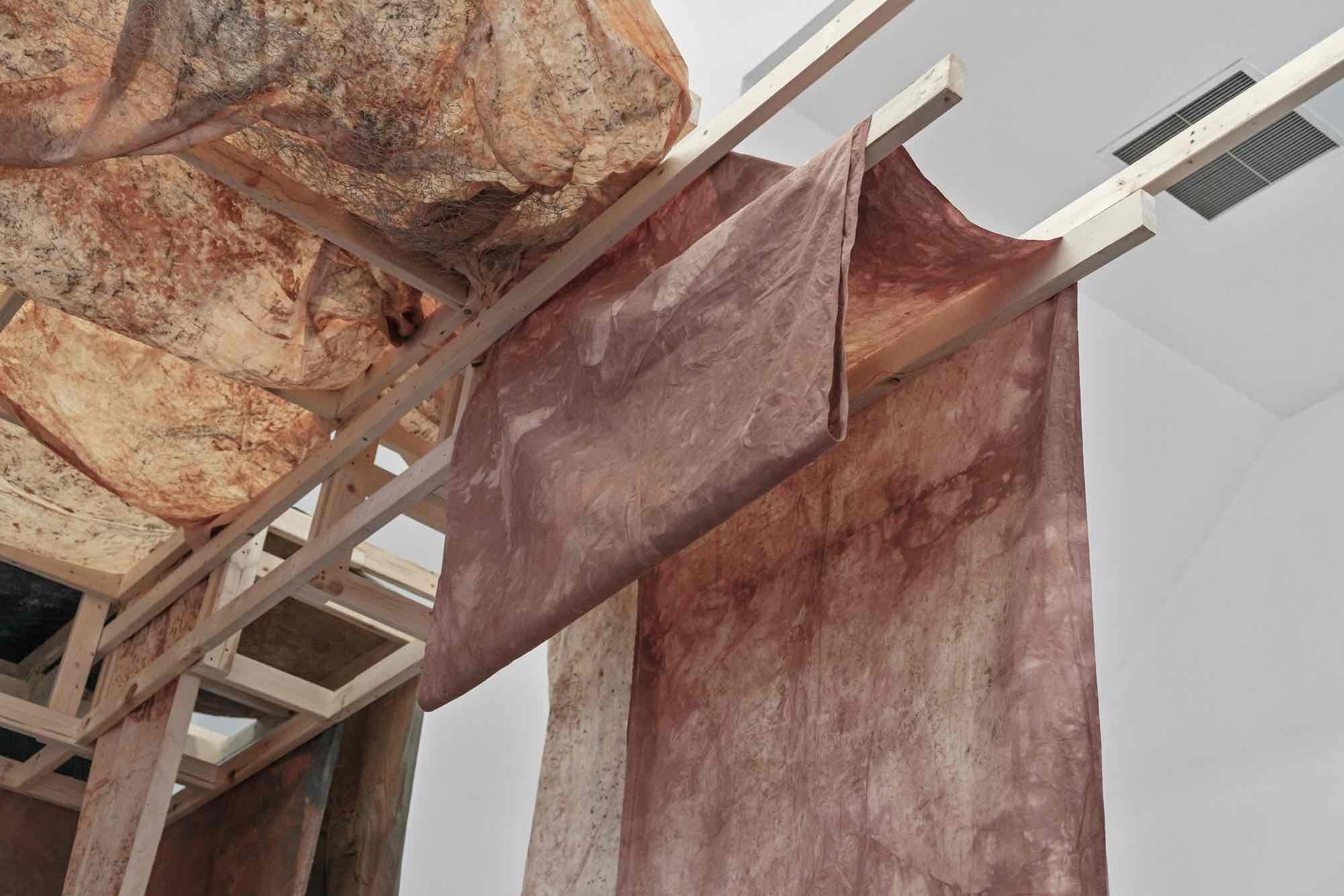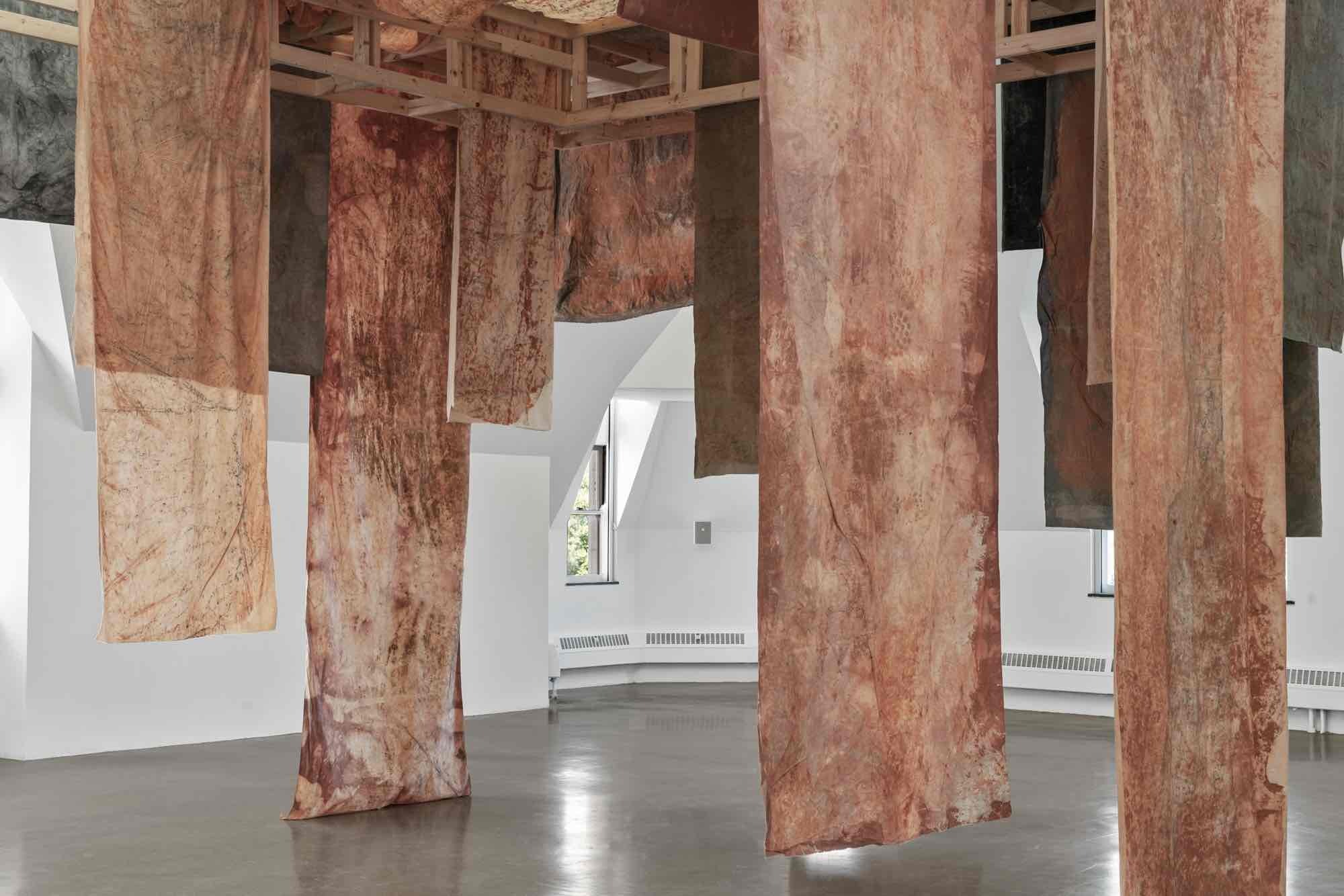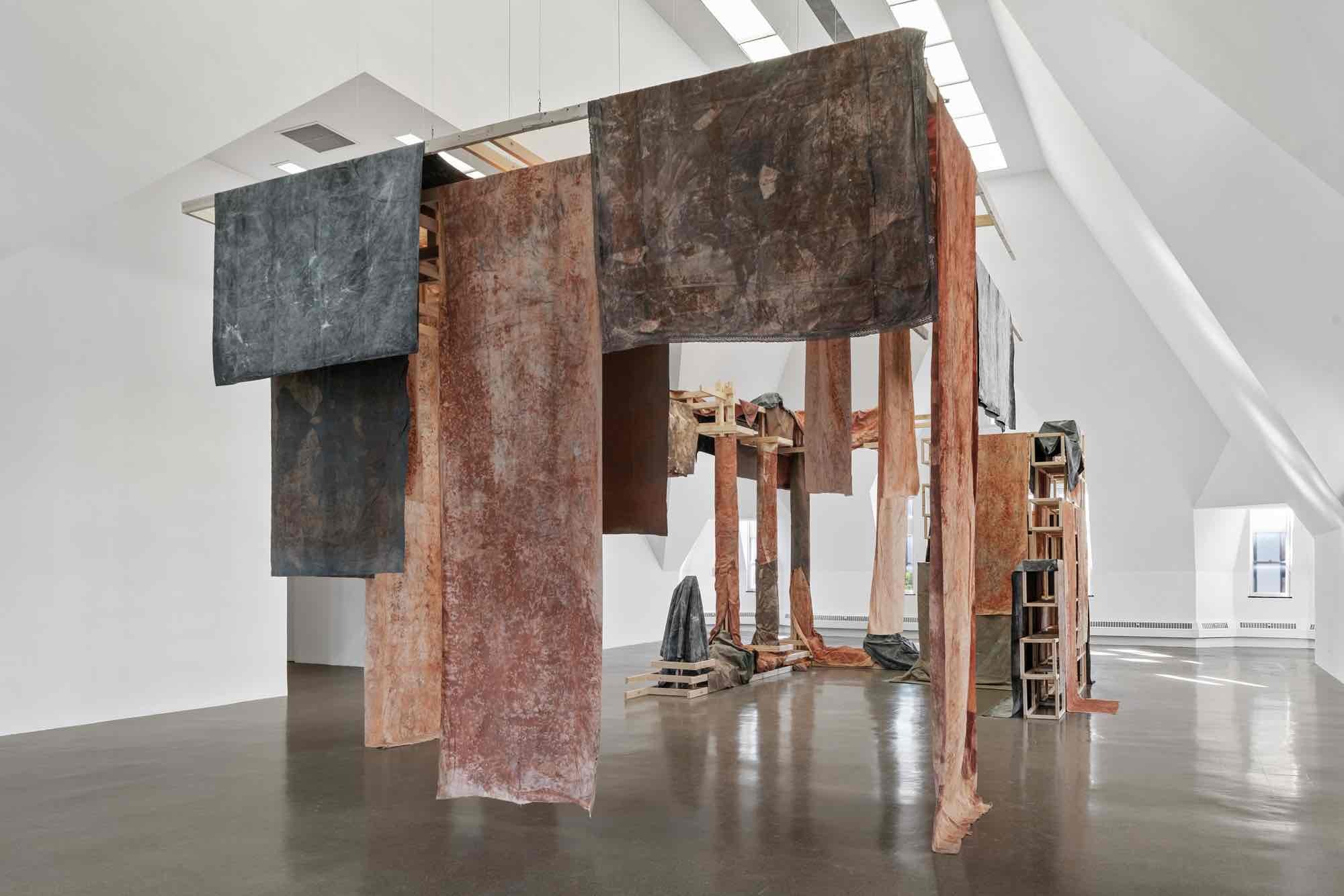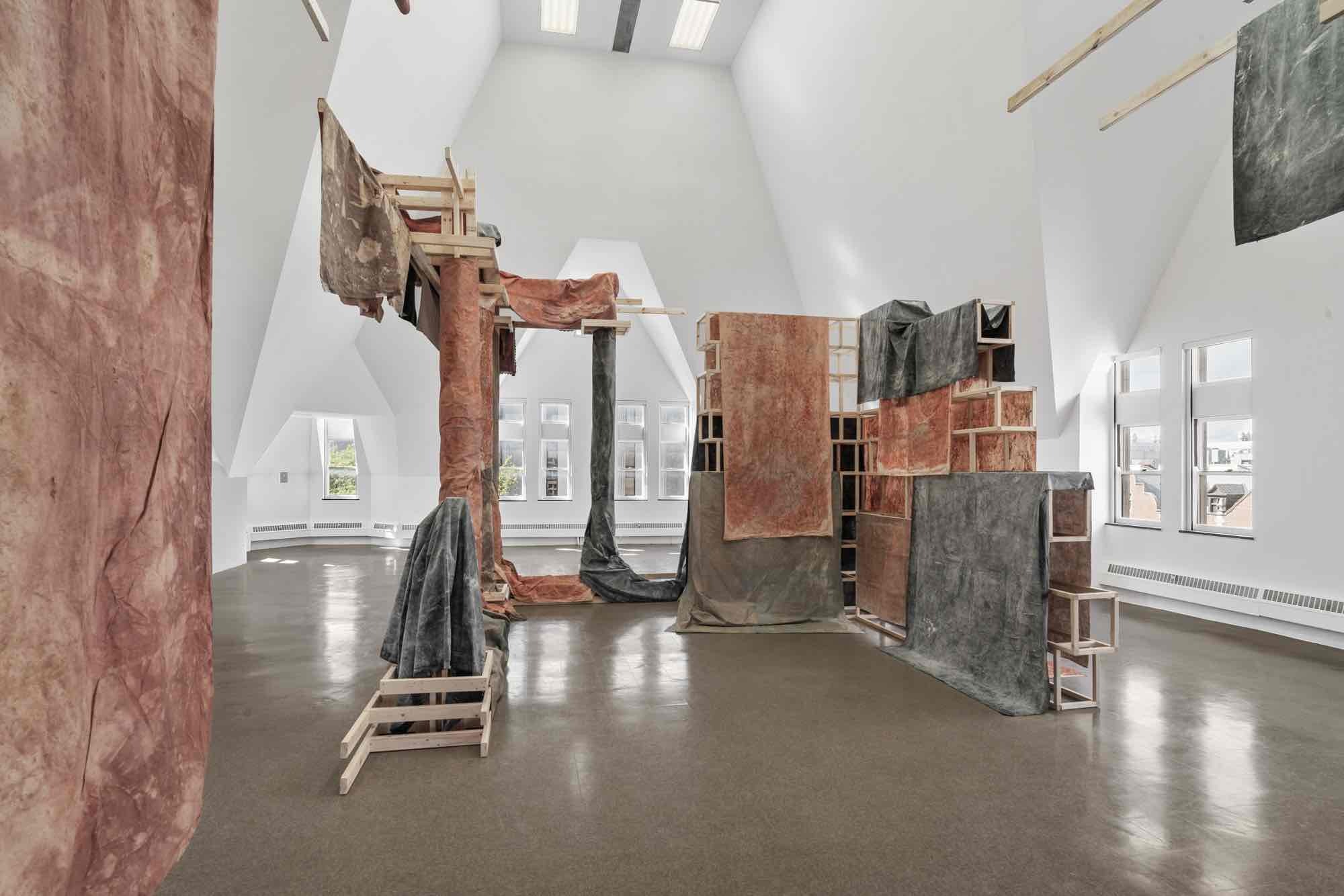Dala Nasser
ADONIS RIVER
16 Sep - 26 Nov 2023
Dala Nasser presents a new site-specific commission that responds to the expansive height and volume of the Renaissance Society’s exhibition space.
Nasser’s project centers on the Adonis River, known in modern day Lebanon as Nahr Ibrahim or Abraham River and located in the region of Mount Lebanon. According to myth, this is where Adonis, the mortal lover of the Goddess Aphrodite, was killed by a wild boar. To this day, the myths surrounding this river are commemorated in pilgrimages of mourning and grief. Nasser made the paintings for the exhibition inside the cave where Adonis was killed, on fabrics that she rubbed on-site then dyed with iron oxide-rich local clay (and sometimes with ashes) and washed in the river’s water. Each spring, the melting snows flood the river, bringing a reddish mud into the stream from the clay-rich soil of the mountain slopes. The red stain can be seen feeding into the river and flowing far out to the Mediterranean. Legend held this to be the blood of Adonis, renewed each year, at the time of his death.
This location, with its mythical significance, allowed Nasser to experiment with materials and alchemies while thinking through the histories of collective mourning practices and their social and political implications. In fact, mourning rituals are an ongoing thread in Nasser’s practice as many of her works, including this one, integrate the black shroud carried and displayed during Ashura, a Shia-muslim ritual of mourning gatherings, processions, and dramatic reenactments. Rather than hanging on walls, her works here are configured into three-dimensional spatial environments that evoke the Adonis temple, the cave, and its surroundings, in addition to hinting at American neoclassical architecture and its mimicry of ancient Greek forms.
The installation is accompanied by an hour-long four-channel sound piece made in collaboration with artist Mhamad Safa. It consists of mourning prayers recorded and slowed down by the artists forty times—a figure which references a mourning period shared across many cultures and faiths, understood to be the number of days it takes for a soul to transfer to the afterlife. This composition was then played back inside the cave and temple and re-recorded, folding in each site’s natural resonances along with sounds from the surrounding environment.
As an artist working through abstraction and alternative forms of image-making, Nasser integrates sound, performance and film in her practice, but remains quintessentially a painter as she thinks specifically through this medium and its most elementary materials: fabric, pigments, stretcher bars, lines. Her indexical paintings of land, made through direct contact on location, stand in opposition to the sweeping vistas offered by traditional landscape painting. In contrast, Nasser’s canvases provide close-up views of the markings of political and environmental conditions. Considering materials as witnesses, she has developed a growing body of work that foregrounds non-claimed histories, ecologies of slow violence, colonial theft, and infrastructural failure in times and places where human language has been rendered insufficient or out of reach.
Curated by Myriam Ben Salah.
Nasser’s project centers on the Adonis River, known in modern day Lebanon as Nahr Ibrahim or Abraham River and located in the region of Mount Lebanon. According to myth, this is where Adonis, the mortal lover of the Goddess Aphrodite, was killed by a wild boar. To this day, the myths surrounding this river are commemorated in pilgrimages of mourning and grief. Nasser made the paintings for the exhibition inside the cave where Adonis was killed, on fabrics that she rubbed on-site then dyed with iron oxide-rich local clay (and sometimes with ashes) and washed in the river’s water. Each spring, the melting snows flood the river, bringing a reddish mud into the stream from the clay-rich soil of the mountain slopes. The red stain can be seen feeding into the river and flowing far out to the Mediterranean. Legend held this to be the blood of Adonis, renewed each year, at the time of his death.
This location, with its mythical significance, allowed Nasser to experiment with materials and alchemies while thinking through the histories of collective mourning practices and their social and political implications. In fact, mourning rituals are an ongoing thread in Nasser’s practice as many of her works, including this one, integrate the black shroud carried and displayed during Ashura, a Shia-muslim ritual of mourning gatherings, processions, and dramatic reenactments. Rather than hanging on walls, her works here are configured into three-dimensional spatial environments that evoke the Adonis temple, the cave, and its surroundings, in addition to hinting at American neoclassical architecture and its mimicry of ancient Greek forms.
The installation is accompanied by an hour-long four-channel sound piece made in collaboration with artist Mhamad Safa. It consists of mourning prayers recorded and slowed down by the artists forty times—a figure which references a mourning period shared across many cultures and faiths, understood to be the number of days it takes for a soul to transfer to the afterlife. This composition was then played back inside the cave and temple and re-recorded, folding in each site’s natural resonances along with sounds from the surrounding environment.
As an artist working through abstraction and alternative forms of image-making, Nasser integrates sound, performance and film in her practice, but remains quintessentially a painter as she thinks specifically through this medium and its most elementary materials: fabric, pigments, stretcher bars, lines. Her indexical paintings of land, made through direct contact on location, stand in opposition to the sweeping vistas offered by traditional landscape painting. In contrast, Nasser’s canvases provide close-up views of the markings of political and environmental conditions. Considering materials as witnesses, she has developed a growing body of work that foregrounds non-claimed histories, ecologies of slow violence, colonial theft, and infrastructural failure in times and places where human language has been rendered insufficient or out of reach.
Curated by Myriam Ben Salah.

